Cisco IE 5000 Service Manual

Cisco IE 5000 Hardened Aggregator Hardware
Installation Guide
First Published: September 2015
Last Updated: April 2018
Cisco Systems, Inc. www.cisco.com
THE SPECIFICATIONS AND INFORMATION REGARDING THE PRODUCTS IN THIS MANUAL ARE SUBJECT TO CHANGE WITHOUT NOTICE. ALL STATEMENTS, INFORMATION, AND RECOMMENDATIONS IN THIS MANUAL ARE BELIEVED TO BE ACCURATE BUT ARE PRESENTED WITHOUT WARRANTY OF ANY KIND, EXPRESS OR IMPLIED. USERS MUST TAKE FULL RESPONSIBILITY FOR THEIR APPLICATION OF ANY PRODUCTS.
THE SOFTWARE LICENSE AND LIMITED WARRANTY FOR THE ACCOMPANYING PRODUCT ARE INCORPORATED HEREIN BY THIS REFERENCE. IF YOU ARE UNABLE TO LOCATE THE SOFTWARE LICENSE OR LIMITED WARRANTY, CONTACT YOUR CISCO REPRESENTATIVE FOR A COPY.
The following information is for FCC compliance of Class A devices: This equipment has been tested and found to comply with the limits for a Class A digital device, pursuant to part 15 of the FCC rules. These limits are designed to provide reasonable protection against harmful interference when the equipment is operated in a commercial environment. This equipment generates, uses, and can radiate radio-frequency energy and, if not installed and used in accordance with the instruction manual, may cause harmful interference to radio communications. Operation of this equipment in a residential area is likely to cause harmful interference, in which case users will be required to correct the interference at their own expense.
The following information is for FCC compliance of Class B devices: This equipment has been tested and found to comply with the limits for a Class B digital device, pursuant to part 15 of the FCC rules. These limits are designed to provide reasonable protection against harmful interference in a residential installation. This equipment generates, uses and can radiate radio frequency energy and, if not installed and used in accordance with the instructions, may cause harmful interference to radio communications. However, there is no guarantee that interference will not occur in a particular installation. If the equipment causes interference to radio or television reception, which can be determined by turning the equipment off and on, users are encouraged to try to correct the interference by using one or more of the following measures:
■Reorient or relocate the receiving antenna.
■Increase the separation between the equipment and receiver.
■Connect the equipment into an outlet on a circuit different from that to which the receiver is connected.
■Consult the dealer or an experienced radio/TV technician for help.
Modifications to this product not authorized by Cisco could void the FCC approval and negate your authority to operate the product.
The Cisco implementation of TCP header compression is an adaptation of a program developed by the University of California, Berkeley (UCB) as part of UCB’s public domain version of the UNIX operating system. All rights reserved. Copyright © 1981, Regents of the University of California.
NOTWITHSTANDING ANY OTHER WARRANTY HEREIN, ALL DOCUMENT FILES AND SOFTWARE OF THESE SUPPLIERS ARE PROVIDED “AS IS” WITH ALL FAULTS. CISCO AND THE ABOVE-NAMED SUPPLIERS DISCLAIM ALL WARRANTIES, EXPRESSED OR IMPLIED, INCLUDING, WITHOUT LIMITATION, THOSE OF MERCHANTABILITY, FITNESS FOR A PARTICULAR PURPOSE AND NONINFRINGEMENT OR ARISING FROM A COURSE OF DEALING, USAGE, OR TRADE PRACTICE.
IN NO EVENT SHALL CISCO OR ITS SUPPLIERS BE LIABLE FOR ANY INDIRECT, SPECIAL, CONSEQUENTIAL, OR INCIDENTAL DAMAGES, INCLUDING, WITHOUT LIMITATION, LOST PROFITS OR LOSS OR DAMAGE TO DATA ARISING OUT OF THE USE OR INABILITY TO USE THIS MANUAL, EVEN IF CISCO OR ITS SUPPLIERS HAVE BEEN ADVISED OF THE POSSIBILITY OF SUCH DAMAGES.
Any Internet Protocol (IP) addresses and phone numbers used in this document are not intended to be actual addresses and phone numbers. Any examples, command display output, network topology diagrams, and other figures included in the document are shown for illustrative purposes only. Any use of actual IP addresses or phone numbers in illustrative content is unintentional and coincidental.
All printed copies and duplicate soft copies are considered un-Controlled copies and the original on-line version should be referred to for latest version.
Cisco has more than 200 offices worldwide. Addresses, phone numbers, and fax numbers are listed on the Cisco website at www.cisco.com/go/offices.
© 2018 Cisco Systems, Inc. All rights reserved.
ii

Preface
Audience
This guide is for the networking or computer technician responsible for installing Cisco IE 5000 series switches. We assume that you are familiar with the concepts and terminology of Ethernet and local area networking.
Purpose
This guide documents the hardware features of the Cisco IE 5000 switches. It describes the physical and performance characteristics of each switch, explains how to install a switch, and provides troubleshooting information.
This guide does not describe system messages that you might receive or how to configure your switch. For more information, see the Cisco IE5000 documentation:
http://www.cisco.com/c/en/us/support/switches/industrial-ethernet-5000-series-switches/tsd-products-support-series-home.html
For information about the standard Cisco IOS commands, see
http://www.cisco.com/cisco/web/psa/configure.html?mode=prod&level0=268438303
Also refer to the printed IE5000 Product Document of Compliance, included with the switch in the packaging, for Hazardous Location and Compliance information.
Conventions
This document uses the following conventions and symbols for notes, cautions, and warnings.
Note: Means reader take note. Notes contain helpful suggestions or references to materials not contained in this manual.
Caution: Means reader be careful. In this situation, you might do something that could result in equipment damage or loss of data.
Warning: This warning symbol means danger. You are in a situation that could cause bodily injury. Before you work on any equipment, be aware of the hazards involved with electrical circuitry and be familiar with standard practices for preventing accidents. Use the statement number provided at the end of each warning to locate its translation in the translated safety warnings that accompanied this device. Statement 1071
The safety warnings for this product are translated into several languages in the Regulatory Compliance and Safety Information for the Cisco IE 5000 Switch that ships with the product. The EMC regulatory statements are also included in that guide.
Related Publications
Before installing, configuring, or upgrading the switch, see the release notes on Cisco.com for the latest information.
These documents provide complete information about the switch and are available on Cisco.com:
Regulatory Compliance and Safety Information for the Cisco IE 5000 Switch
Cisco Systems, Inc. www.cisco.com iii

Obtaining Documentation, Obtaining Support, and Security Guidelines
Release Notes for the Cisco IE 5000 Switch
Cisco IE 5000 Switch Software Configuration Guide
Device Manager Online help (available on the switch)
These compatibility matrix documents are available from this Cisco.com site:
http://www.cisco.com/en/US/products/hw/modules/ps5455/products_device_support_tables_list.html
Cisco Gigabit Ethernet Transceiver Modules Compatibility Matrix (not orderable but available on Cisco.com)
Cisco Small Form-Factor Pluggable Modules Compatibility Matrix (not orderable but available on Cisco.com)
Obtaining Documentation, Obtaining Support, and Security Guidelines
For information on obtaining documentation, obtaining support, providing documentation feedback, security guidelines, and also recommended aliases and general Cisco documents, see the monthly What’s New in Cisco Product Documentation, which also lists all new and revised Cisco technical documentation, at:
http://www.cisco.com/en/US/docs/general/whatsnew/whatsnew.html
iv

Product Overview
The Cisco IE 5000 hardened aggregator provides a rugged and secure switching infrastructure for harsh environments. It is suitable for industrial Ethernet applications, including process manufacturing, intelligent transportation systems (ITSs), rail transportation, and other similar deployments.
In industrial environments, you can connect the switch to any Ethernet-enabled industrial communication devices, including programmable logic controllers (PLCs), human-machine interfaces (HMIs), drives, sensors, and input and output (IO) devices.
For detailed specifications, see the IE 5000 Data Sheet.
Switch Models, page 1
Cable Side, page 2
Power-Supply Side, page 10
Management Options, page 12
Switch Models
Table 1 |
Switch Models |
|
|
|
|
|
|
|
|
|
|
|
|
|
|
Model |
|
Total |
SFP/SFP+ |
FE/GE SFP |
Copper |
Default |
Power Supplies |
|
|
Ports |
Uplinks |
Downlinks |
10/100/1000 |
Software |
|
|
|
|
|
|
PoE/PoE+1 |
License2 |
|
|
|
|
|
|
Ports |
|
|
|
|
|
|
|
|
|
|
IE-5000-16S12P |
28 |
4 GE only |
12 |
12 |
LAN Base |
Support for 2 field-replaceable, redundant |
|
|
|
|
|
|
|
|
AC or DC power supplies. |
|
|
|
|
|
|
|
For detailed specifications, see the |
|
|
|
|
|
|
|
IE 5000 Data Sheet. |
|
|
|
|
|
|
|
|
IE-5000-12S12P-10G |
28 |
4GE/10GE |
12 |
12 |
LAN Base |
Support for 2 field-replaceable, redundant |
|
|
|
|
|
|
|
|
AC or DC power supplies. |
|
|
|
|
|
|
|
For detailed specifications, see the |
|
|
|
|
|
|
|
IE 5000 Data Sheet. |
|
|
|
|
|
|
|
|
1.PoE+ = Power over Ethernet.
2.Can be upgraded to IP Services at a fee. IP Services License Product Numbers are the following: L-IE5000-RTU= (Electronic SW License for IE5000 Switches)
Cisco Systems, Inc. www.cisco.com
1
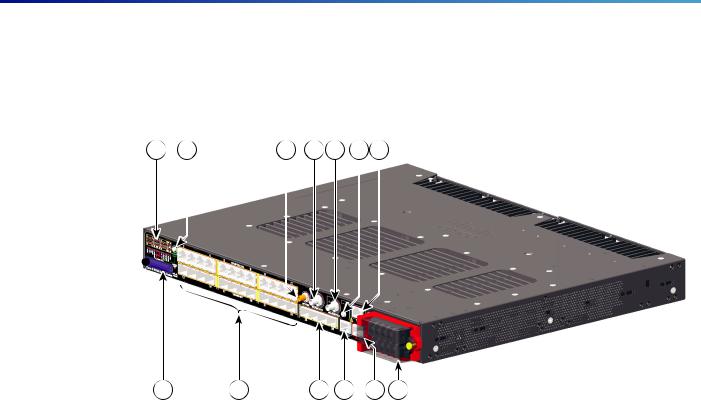
Product Overview
Cable Side
Cable Side
Figure 1 Cisco IE-5000 Cable-Side View
1 |
2 |
3 |
4 |
5 |
6 |
7 |
13 |
12 |
11 |
10 |
9 |
8 |
349768
1 |
LEDs |
8 |
Power-input terminal |
|
|
|
|
2 |
Display mode button |
9 |
Alarm port |
|
|
|
|
3 |
GPS antenna port |
10 |
Console port |
|
|
|
|
4 |
Digital Timecode I/O (IRIG) |
11 |
Four 1000 SFP/10G SFP+ Ports (Uplinks) |
|
(Not currently supported by software) |
|
|
|
|
|
|
5 |
Analog Timecode I/O (IRIG) |
12(top) |
Twelve 10/100/1000 PoE/PoE+ Ports (Downlinks) |
|
(Not currently supported by software) |
|
|
|
|
|
|
6 |
USB (mini-Type B) console port |
12 (bottom) |
Twelve 100/1000 SFP Ports (Downlinks) |
|
|
|
|
7 |
Time of Day (TOD) Port |
13 |
Flash memory card slot |
|
(Not currently supported by software) |
|
|
|
|
|
|
LEDs
For detailed information about LEDs see LEDs, page 5.
Display Mode Button
For detailed functionality see Display Mode Button, page 8.
GPS Antenna Port
GNSS Module RF Input Requirements
The GPS/GNSS input requires a GPS/GNSS receive antenna with built-in Low-Noise Amplifier (LNA) for optimal performance. The LNA amplifies the received satellite signals to:
Compensate for cable loss
Increase the signal amplitude to a suitable range for the receiver front-end
2

Product Overview
Cable Side
The amplification required is 22dB gain + cable loss + connector loss.
The recommended range of LNA gain (LNA gain minus all cable and connector losses) at the connector of the receiver input is 22dB to 30dB with a minimum of 20dB and a maximum of 35dB.
The GPS/GNSS input on the IE 5000 provides 3.3 or 5VDC (software configurable) to the antenna through the same RF connector. The antenna should draw between 10 and 100mA. An antenna that draws less than 10mA may wrongly report and "Antenna Open" fault even though the antenna is operating properly.
Power Requirements
When deployed in a hazardous environment the antenna shall only use power provided by the RF input from a single IE 5000. No additional power may be supplied to the antenna and associated equipment.
Caution: Supplying additional power, such as with a powered splitter or amplified repeater, may provide enough energy to create an arc that could ignite the explosive atmosphere.
Surge requirement:
The GPS/GNSS input has built-in ESD protection. If an outdoor antenna is being connected, additional surge protection will be required to meet the regulations and standards for lightning protection in the countries where the end-product is installed.
The lightning protection must be mounted at the place where the antenna cable enters the building. The primary lightning protection must be certified for conducting all potentially dangerous electrical energy to PE (Protective Earth). Surge arrestors should support DC-pass and be suitable for the GPS/GNSS frequency range with low RF attenuation.
Caution: The antenna terminal should be earthed at the building entrance in accordance with the ANSI/NFPA 70, the National Electrical Code (NEC), in particular Section 820.93, Grounding of Outer Conductive Shield of a Coaxial Cable.
Antenna Sky visibility:
GPS signals require a direct line of sight between antenna and satellite. The antenna should see as much of the sky as possible. Fixed installations require four satellites in view for an initial time fix, while subsequent updates may be possible with fewer satellites.
Console Ports
You can connect the switch to a PC running Microsoft Windows or to a terminal server through either the RJ-45 console port or the USB console port.
RJ-45 console port. The RJ-45 connection uses an RJ-45-to-DB-9 female cable.
USB mini-Type B console port (5-pin connector). The USB connection uses a USB Type A-to-5-pin mini-Type B cable. The USB console interface speeds are the same as the RJ-45 console interface speeds.
To use the USB console port, you must install the Cisco Windows USB device driver on the device that is connected to the USB console port (device running with Microsoft Windows). See Installing the Cisco Microsoft Windows XP, 2000, Vista, 7, 8, and 10 USB Device Driver, page 64 for more information.
With the Cisco Windows USB device driver, connecting and disconnecting the USB cable from the console port does not affect Windows HyperTerminal operations. Mac OS X or Linux require no special drivers.
Note: The 5-pin mini-Type B connectors resemble the 4-pin mini-Type B connectors. They are not compatible. Use only the 5-pin mini-Type B.
3
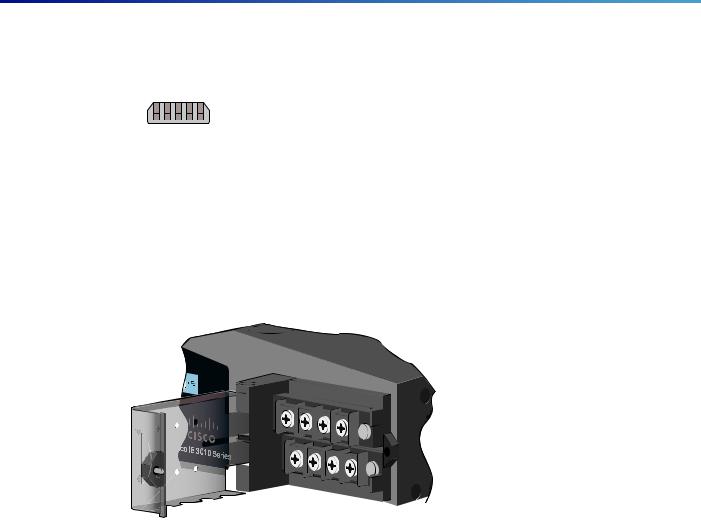
Product Overview
Cable Side
Figure 2 USB Mini-Type B Port
 253163
253163
The configurable inactivity timeout reactivates the RJ-45 console port if the USB console port is activated, but no input activity occurs on it for a specified time period. When the USB console port deactivates due to a timeout, you can restore its operation by disconnecting and reconnecting the USB cable. For information on using the CLI to configure the USB console interface, see the switch software guide.
Power-Input Terminal
The power-input terminal provides screw terminals for the AC and DC power connections. The switch can operate with one or two power supplies. If one of the power sources fail, the other continues to power the switch. See Power Supply Installation, page 33 for information.
Figure 3 Power-Input Terminal
208415
Alarm Ports
The switch has four alarm inputs and one alarm output.
Alarm Input
The alarm input is a dry-contact alarm port. You can connect up to four alarm inputs from devices, such as a door, a temperature gauge, or a fire alarm, to the alarm port. You can use the CLI to set the alarm severity to minor, or major. An alarm generates a system message and turns on an LED. See the Alarm LEDs, page 9 for the LED descriptions.
Alarm Output
The alarm output can be configured as a major alarm. Output alarms often control an external alarm, such as a bell or a light. To connect an external alarm device to the relay, you connect two relay contact wires to complete the electrical circuit. See for information on the alarm pinouts. see the Alarm Port, page 54.
Four 1000 SFP/10G SFP+ Ports (Uplinks)
Depending on the switch model, the uplink ports support either GE optics and 10G optics, or only GE optics. When using a 1000BaseT SFP, the port only operates at 1000 mbps.
For more information about SFP/SFP+ modules and cables, see Transceiver Modules. See Switch Models, page 1 for model information.
4

Product Overview
Cable Side
100/1000 SFP Ports (Downlinks)
The switch Ethernet SFP modules provide connections to other devices. These field-replaceable transceiver modules provide the downlink interfaces. The IE 5000 supports both FE and GE optics in the downlinks. SFP modules have local connectors (LCs) for fiber-optic connections or RJ-45 connectors for copper connections.
For the most up-to-date list of supported SFP models, see the IE 5000 Data Sheet.
For information about SFP modules, see your SFP module documentation and the Installing and Removing SFP Modules, page 25. For more information about SFP/SFP+ modules and cables, see Transceiver Modules.
10/100/1000 PoE/PoE+ Ports (Downlinks)
You can set the 10/100/1000 ports on the switch to operate in any combination of half duplex, full duplex, or 10 or 100 Mb/s. You can set the ports for speed and duplex autonegotiation. The default setting is autonegotiate.
When set for autonegotiation, the switch determines the speed and duplex settings of the attached device and advertises its own capabilities. If the connected device also supports autonegotiation, the switch negotiates the best connection (the fastest line speed that both devices support and full-duplex transmission if the attached device supports it) and configures itself accordingly. In all cases, the attached device must be within 328 feet (100 meters).
Warning: Voltages that present a shock hazard may exist on Power over Ethernet (PoE) circuits if interconnections are made using uninsulated exposed metal contacts, conductors, or terminals. Avoid using such interconnection methods, unless the exposed metal parts are located within a restricted access location and users and service people who are authorized within the restricted access location are made aware of the hazard. A restricted access area can be accessed only through the use of a special tool, lock and key or other means of security. Statement 1072
The 10/100/1000 PoE ports on the Cisco IE-5000 switches provide PoE support for devices that are compliant with IEEE 802.3af/802.3at. The Cisco prestandard PoE is also supported for Cisco IP Phones and Cisco Aironet Access Points. The PoE ports on the switch deliver up to 30 W of PoE+ power. All twelve ports are PoE ports and can be assigned a port priority.
Refer to Table 15 on page 71 for power supply configuration and PoE power budget information.
On a per-port basis, you control whether or not a port automatically provides power when an IP phone or an access point is connected.
The 10/100/1000 PoE ports use RJ-45 connectors with Ethernet pinouts. The maximum cable length is 328 feet (100 meters). The 100BASE-TX and 1000BASE-T traffic requires CA5, CAT5e, or CAT6 unshielded twisted pair (UTP) cable. The 10BASE-T traffic can use CAT3 or CAT4 UTP cable.
For information about configuring and monitoring PoE ports, see the switch software configuration guide on Cisco.com.
For information about port connections and port specifications, see Connecting Devices to the Ethernet Ports, page 30.
Note: The output of the PoE circuit has been evaluated as a Limited Power Source (LPS) per IEC 60950-1.
SD Flash Memory Card
The switch supports a flash memory card that makes it possible to replace a failed switch without reconfiguring the new switch. The slot for the flash memory card is on the front of the switch. The flash card is hot swappable and can be accessed on the front panel in non hazardous locations only. A cover protects the flash card and holds the card firmly in place. The cover is hinged and closed with a captive screw. This prevents the card from coming loose and protects against shock and vibration.
For more information on inserting and removing the flash memory card, see Power-Supply Side, page 10.
LEDs
You can use the switch system and port LEDs to monitor switch activity and performance.
5
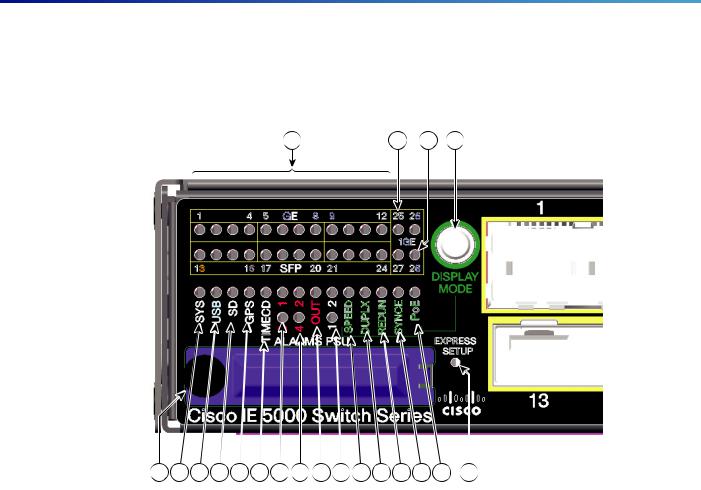
Product Overview
Cable Side
Switch Panel LEDs
Figure 4 Switch LEDs (Cable Side)
1 |
2 |
3 |
4 |
20 19 18 17 16 15 14 13 |
12 11 10 |
9 |
8 |
7 |
6 |
5 |
349769
1 |
Ethernet ports |
11 |
PSU1 and 2 (power supply 1 and 2) |
|
|
|
|
2 |
10G Ethernet ports |
12 |
OUT (alarm output) |
|
|
|
|
3 |
10G Ethernet ports |
13 |
Alarms 2 and 4 |
|
|
|
|
4 |
Display mode switch |
14 |
Alarms 1 and 3 |
|
|
|
|
5 |
Express Setup button |
15 |
Timecode status (not currently supported by software) |
|
|
|
|
6 |
PoE |
16 |
GPS status |
|
|
|
|
7 |
Synchronous Ethernet status |
17 |
SD (SD flash memory card) |
|
|
|
|
8 |
Redundancy status |
18 |
USB (mini-USB console) |
|
|
|
|
9 |
Port duplex status |
19 |
SYS (system) |
|
|
|
|
10 |
Port speed status |
20 |
SD card slot cover |
|
|
|
|
Port LEDs
Each Ethernet port has a port LED. These port LEDs, display information about the individual ports. The port mode determines the type of information shown by the port LEDs. Table 2 on page 7 lists the mode LEDs and their associated port modes and meanings.
To select or change a mode, press the Mode button until the desired mode is highlighted. The Mode LED will turn ON solid green when a mode is selected and turn OFF when timeout (5 seconds) or a different mode is selected. When you change port modes, the meanings of the port LED colors also change. Table 3 on page 7 explains how to interpret the port LED colors in different port modes.
6

Product Overview
Cable Side
Table 2 |
Port Mode LEDs |
|
|
|
|
|
|
Mode LED |
|
Port Mode |
Description |
|
|
|
|
All Off |
|
Port status |
The port status. This is the default mode. |
|
|
|
|
SPEED |
|
Port speed |
The port operating speed: 10, 100, 1000 mbps or 10 Gbps. |
|
|
|
|
DUPLX |
|
Port duplex mode |
The port duplex mode: full duplex or half duplex. |
|
|
|
|
REDUN |
|
Redundancy status |
Parallel Redundancy Protocol (PRP) status. |
|
|
|
|
SYNCE |
|
Synchronous Ethernet status |
Not supported by software yet. Mode button skips this LED. |
|
|
|
|
PoE |
|
PoE+ port power |
The PoE+ port status. |
|
|
|
|
Table 3 |
Meaning of Switch LED Colors in Different Modes |
|||
|
|
|
|
|
Port Mode LED |
Port LED Color |
|
Meaning |
|
|
|
|
|
|
All Off |
|
Off |
|
No link, or port was administratively shut down. |
|
|
|
|
|
|
|
Green |
|
Link present, no activity. |
|
|
|
|
|
|
|
Blinking green |
|
Activity. Port is sending or receiving data. |
|
|
|
|
|
|
|
Alternating |
|
Link fault. Error frames can affect connectivity, and errors such as excessive collisions, CRC |
|
|
green-amber |
|
errors, and alignment and jabber errors are monitored for a link-fault indication. |
|
|
|
|
|
|
|
Amber |
|
Port is blocked by Spanning Tree Protocol (STP) and is not forwarding data. |
|
|
|
|
After a port is reconfigured, the port LED can be amber for up to 30 seconds as STP checks the |
|
|
|
|
switch for possible loops. |
|
|
|
|
|
SPEED |
|
10/100/1000/SFP ports |
|
|
|
|
|
|
|
|
|
Downlink Ports |
|
|
|
|
|
|
|
|
|
Off |
|
Port is not operating. |
|
|
|
|
|
|
|
Amber |
|
Port is operating at 10 Mb/s. |
|
|
|
|
|
|
|
Green |
|
Port is operating at 100 Mb/s. |
|
|
|
|
|
|
|
Flashing green |
|
Port is operating at 1000 Mb/s. |
|
|
|
|
|
|
|
Uplinks Ports |
|
|
|
|
|
|
|
|
|
Green |
|
Port is operating at 1000 Mb/s. |
|
|
|
|
|
DUPLX |
|
Off |
|
Port is not operating. |
(duplex) |
|
|
|
|
|
Amber |
|
Port is operating in half duplex. |
|
|
|
|
||
|
|
|
|
|
|
|
Green |
|
Port is operating in full duplex. |
|
|
|
|
|
REDUN |
|
Green |
|
One or more redundancy protocols are configured and active (for example, HSR, DLR, PRP, |
|
|
|
|
etc.) |
|
|
|
|
|
|
|
Blinking amber |
|
One or more redundancy protocols are indicating a redundancy fault. |
|
|
|
|
|
|
|
Fast blinking green |
|
The port LEDs are showing ports that are participating in a redundancy protocol and the |
|
|
|
|
redundancy fault status of that port. |
|
|
|
|
|
SYNCE |
|
Off |
|
|
|
|
|
|
|
7

Product Overview
Cable Side
Table 3 |
Meaning of Switch LED Colors in Different Modes (continued) |
||
|
|
|
|
Port Mode LED |
Port LED Color |
Meaning |
|
|
|
|
|
PoE/PoE+ |
|
Off |
PoE/PoE+ is off. |
|
|
|
If the powered device is receiving power from an AC power source, the port LED is off even if |
|
|
|
the device is connected to the switch port. |
|
|
|
|
|
|
Green |
PoE/PoE+ is on and all ports function correctly. The port LED is green when the switch port is |
|
|
|
providing power. |
|
|
|
|
|
|
Alternating green and |
PoE/PoE+ is on but one of the low priority ports power is disconnected or failed. |
|
|
amber |
|
|
|
|
|
|
|
Blinking amber |
PoE/PoE+ is on but one of the high priority ports power is disconnected or failed. |
|
|
|
PoE+ faults occur when noncompliant cabling or powered devices are connected to a PoE+ port. |
|
|
|
Use only standard-compliant cabling to connect Cisco prestandard IP Phones and wireless |
|
|
|
access points or IEEE 802.3af/at-compliant devices to PoE+ ports. You must remove from the |
|
|
|
network any cable or device that causes a PoE+ fault. |
|
|
|
|
|
|
Amber |
PoE/PoE+ is on with failures. |
|
|
|
PoE+ is enabled by default. |
|
|
|
|
Display Mode Button
The Display Mode Button allows you to choose the mode you want displayed by the port LEDs (items 1-3 in Figure 4 on page 6). The LEDs with green text to the left of the Button indicate the chosen display mode. Each time you press the switch, the mode indicator moves from SPEED, DUPLX, REDUN, SYNCE, and PoE respectively.
Power-Supply Module LEDs
The switch power-supply module LEDs are labeled PSU1 and PSU2 (on the switch) and PSU OK (on the power-supply module). They show whether power-supply modules 1 and 2 are receiving power.
Table 4 |
Power Supply Module LEDs |
|
|
|
|
Color |
|
System Status |
|
|
|
Off |
|
Power-supply module (1 or 2) is not installed. |
|
|
|
Green |
|
Valid input is present, and the output is within the operating range. |
|
|
|
Red |
|
Valid input is present, and the output is outside the operating range or is not present. |
|
|
|
Blinking red |
|
Power-supply module (1 or 2) is installed but valid input is not present. |
|
|
|
8

Product Overview
Cable Side
Alarm LEDs
Table 5 |
Alarm LEDs |
|
|
|
|
Color |
|
System Status |
|
|
|
1-4 Input Alarms |
||
|
|
|
Green |
|
Alarm not present |
|
|
|
Red |
|
Minor alarm present |
|
|
|
Blinking red |
|
Major alarm present |
|
|
|
Output Alarm |
||
|
|
|
Green |
|
Alarm not present |
|
|
|
Red |
|
Alarm condition present |
|
|
|
SD Flash Memory Card LED
Table 6 |
SD Flash Card LED |
|
|
|
|
Color |
|
System Status |
|
|
|
Fast blinking amber |
Unsupported SD flash memory card is detected. |
|
|
|
|
Slow blinking amber |
SD flash memory card is not present. |
|
|
|
|
Green |
|
SD flash memory card is functioning. |
|
|
|
Blinking green |
SD flash memory card transfer in progress. |
|
|
|
|
USB LED
The USB LED indicates the console port is in use.
If you connect a cable to the console port, the switch automatically uses that port for console communication. If you connect two console cables, the USB console port has priority.
Table 7 |
USB LED |
|
|
|
|
|
|
LED |
|
Color |
Description |
|
|
|
|
USB console port |
Green |
USB console port selected |
|
|
|
|
|
|
|
Off |
RS232 Console selected |
|
|
|
|
9
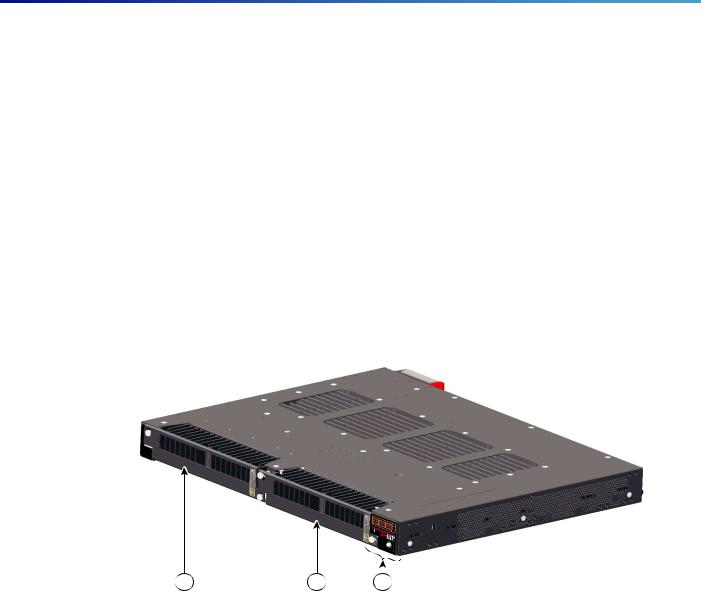
Product Overview
Power-Supply Side
System LED
Table 8 |
System LED |
|
|
|
|
Color |
|
System Status |
|
|
|
Off |
|
System is not powered on. |
|
|
|
Blinking green |
Power-On Self-Test (POST) is in progress. |
|
|
|
|
Green |
|
System is operating normally. |
|
|
|
Red |
|
System is receiving power but is not functioning properly. |
|
|
|
Power-Supply Side
The power-supply side has the LED panel and two power-supply slots for the removable power supplies.
Figure 5 Switch with Both Power-Supply Modules
349771
|
|
|
|
1 |
2 |
3 |
|
1 |
Power Supply slot 1 |
2 |
Power Supply slot 2 |
|
|
|
|
3 |
LED panel |
|
|
|
|
|
|
Note: The 250 W Power Supply is 1.2 in (30 mm) longer than the 150 W versions. Ensure there is adequate space behind the switch for the extra length.
10
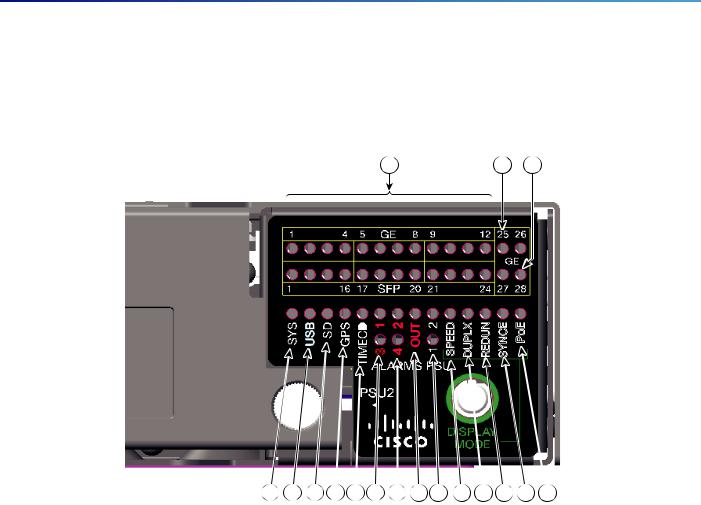
Product Overview
Power-Supply Side
Power-Supply Side LEDs
Figure 6 |
Switch LEDs |
1 |
2 |
3 |
|
|
|
|
|
|
|
|
|
|
|
|
|
349772 |
|
|
|
|
|
|
|
|
|
|
|
|
|
|
|
17 |
16 |
15 |
14 13 12 |
11 |
10 |
9 |
8 |
7 |
6 |
5 |
4 |
|
|
|
|
|
|
|
|
|
|
|
||||
1 |
Ethernet ports |
|
|
|
|
|
10 |
|
OUT (alarm output) |
||||
|
|
|
|
|
|
|
|
|
|
|
|
||
2 &3 |
10G Ethernet ports |
|
|
|
|
|
11 |
|
Alarms 2 and 4 |
|
|
||
|
|
|
|
|
|
|
|
|
|
|
|
||
4 |
PoE |
|
|
|
|
|
12 |
|
Alarms 1 and 3 |
|
|
||
|
|
|
|
|
|
|
|
|
|
||||
5 |
Synchronous Ethernet status |
|
|
|
|
|
13 |
|
Timecode status (not currently supported by |
||||
|
|
|
|
|
|
|
|
|
software) |
|
|
|
|
|
|
|
|
|
|
|
|
|
|
|
|
|
|
6 |
Redundancy status |
|
|
|
|
|
14 |
|
GPS status |
|
|
|
|
|
|
|
|
|
|
|
|
|
|
||||
7 |
Port duplex status |
|
|
|
|
|
15 |
|
SD (SD flash memory card) |
||||
|
|
|
|
|
|
|
|
|
|
||||
8 |
Port speed status |
|
|
|
|
|
16 |
|
USB (mini-USB console) |
||||
|
|
|
|
|
|
|
|
|
|
|
|
||
9 |
PSU1 and 2 (power supply 1and 2) |
|
|
|
|
|
17 |
|
SYS (system) |
|
|
||
|
|
|
|
|
|
|
|
|
|
|
|
|
|
For more information about these LEDs, see Switch Panel LEDs, page 6.
Power Supply Features
The switch has two slots for power-supply modules:
PWR-RGD-LOW-DC-H: low-voltage DC
PWR-RGD-AC-DC-H: high-voltage AC or DC
PWR-RGD-AC-DC-250: high-voltage AC or DC
Note: For detailed specifications, see the IE 5000 Data Sheet.
11

Product Overview
Management Options
Caution: Only the -H and -250 version power supplies are certified safe for hazardous environments.
The switch supports these power-supply module combinations:
Single low-voltage DC
Single high-voltage AC or DC
Two high-voltage AC or DC
Two low-voltage DC
One high-voltage AC or DC and one low-voltage DC
For information on installing the power-supply modules, see Power Supply Installation, page 33.
See Power-Supply Module LEDs, page 8 for information on the power supply LEDs.
Management Options
Cisco IOS CLI
You can configure and monitor the switch from the CLI. Connect your management station to the switch console port or use Telnet from a remote management station. See the switch command reference on Cisco.com for information.
SNMP network management
You can manage switches from a Simple Network Management Protocol (SNMP)-compatible management station. The switch supports a comprehensive set of Management Information Base (MIB) extensions and four Remote Monitoring (RMON) groups. See the switch software configuration guide on Cisco.com and the documentation that came with your SNMP application for information.
Device Manager
You can use Device Manager, which is in the switch memory, to manage individual and standalone switches. This web interface offers quick configuration and monitoring. You can access Device Manager from anywhere in your network through a web browser. For more information, see the Device Manager online help.
Prime Infrastructure
Cisco Prime Infrastructure simplifies the management of wireless and wired networks. It offers Day 0 and 1 provisioning, as well as Day N assurance from the branch to the data center. We call it One Management. With this single view and point of control, you can reap the benefits of One Management across both network and compute.
Network Configurations
See the switch software configuration guide on Cisco.com for an explanation of network configuration concepts. The software configuration guide also provides network configuration examples for creating dedicated network segments that are interconnected through Ethernet connections.
12

Switch Installation
Read the topics and perform the procedures in this order:
Warnings, page 13
Installation Guidelines, page 14
Verifying Switch Operation, page 14
Installing the Switch, page 14
Installing and Removing SFP Modules, page 25
Replacing the SD Flash Memory Card, page 29
Connecting Devices to the Ethernet Ports, page 30
Where to Go Next, page 30
Warnings
These warnings are translated into several languages in the Regulatory Compliance and Safety Information for the Cisco IE 5000 Switch document that ships on the documentation CD.
These warning statements apply to all the switches:
Warning: Before working on equipment that is connected to power lines, remove jewelry (including rings, necklaces, and watches). Metal objects will heat up when connected to power and ground and can cause serious burns or weld the metal object to the terminals. Statement 43
Warning: Read the installation instructions before you connect the system to its power source. Statement 1004
Warning: This unit is intended for installation in restricted access areas. A restricted access area can be accessed only through the use of a special tool, lock and key, or other means of security. Statement 1017
Warning: This equipment must be grounded. Never defeat the ground conductor or operate the equipment in the absence of a suitably installed ground conductor. Contact the appropriate electrical inspection authority or an electrician if you are uncertain that suitable grounding is available. Statement 1024
Warning: This unit might have more than one power supply connection. All connections must be removed to de-energize the unit. Statement 1028
Warning: Only trained and qualified personnel should be allowed to install, replace, or service this equipment. Statement 1030
Warning: Ultimate disposal of this product should be handled according to all national laws and regulations. Statement 1040
Warning: For connections outside the building where the equipment is installed, the following ports must be connected through an approved network termination unit with integral circuit protection.
10/100/1000 Ethernet Statement 1044
Cisco Systems, Inc. www.cisco.com
13

Switch Installation
Installation Guidelines
Warning: To prevent the system from overheating, do not operate it in an area that exceeds the maximum recommended ambient temperature of:
140°F (60°C) Statement 1047
Note: Operating temperatures exceeding 60C are not covered by the product safety certifications and approvals. However, the switch can function in the installations under the environmental conditions listed Switch Specifications, page 70.
Warning: Installation of the equipment must comply with local and national electrical codes. Statement 1074
Note: For U.S. installations, refer to national electrical code ANSI/NFPA 70.
Warning: To prevent airflow restriction, allow clearance around the ventilation openings to be at least: 1.75 in. (4.4 cm). Statement 1076
Warning: Avoid using or servicing any equipment that has outdoor connections during an electrical storm. There may be a risk of electric shock from lightning. Statement 1088
Installation Guidelines
Before installing the switch, verify that these guidelines are met:
Cabling is away from sources of electrical noise, such as radios, power lines, and fluorescent lighting fixtures. Make sure that the cabling is away from other devices that might damage the cables.
Operating environment is within the ranges listed in Technical Specifications, page 69.
Relative humidity around the switch does not exceed 95 percent (non-condensing).
Altitude at the installation site is not higher than 13,800 feet.
For 10/100/1000 fixed ports, cable lengths from the switch to connected devices are not more than 328 feet (100 meters).
For more information about SFP/SFP+ modules and cables, see Transceiver Modules.
Airflow around the switch and through the vents is unrestricted. To prevent overheating, the switch must meet the minimum clearance of 1.75 in. (4.4 cm) at the top and bottom.
Note: If the switch is installed in a closed or multirack assembly, the temperature around it might be greater than normal room temperature. Ensure that the internal temperature does not exceed the maximum ambient temperature specifications for the switch.
Verifying Switch Operation
Before installing the switch in a rack or on a wall, you should power the switch and verify that the switch passes the power-on self-test (POST).
To wire the switch to the power source, see Power-Supply Module Installation, page 35.
When the switch begins POST, the SYS LED blinks green, and the other LEDs stay green. When the switch passes POST, the SYS LED turns green. The other LEDs turn off and return to their operating status. If the switch fails POST, the SYS LED is amber.
Note: Contact Cisco Systems immediately if your switch fails POST.
After a successful POST, disconnect the power from the switch. For more information, see Wiring the Power Source, page 39. See the Installing the Switch, page 14 to install the switch in a rack or on a wall.
Installing the Switch
Rack-Mounting, page 15
14

Switch Installation
Installing the Switch
Wall-Mounting, page 21
Rack-Mounting
To rack-mount the switch, select the rack size and follow the steps in these sections:
Attaching Brackets for 19-Inch Racks, page 15
Attaching Brackets for 19-Inch Racks for IP-30 Compliance (Optional), page 17
Attaching Brackets for 23-Inch Racks, page 19
Attaching Brackets for ETSI Racks, page 20
Rack-Mounting the Switch, page 20
.
Warning: To prevent bodily injury when mounting or servicing this unit in a rack, you must take special precautions to ensure that the system remains stable. The following guidelines are provided to ensure your safety:
This unit should be mounted at the bottom of the rack if it is the only unit in the rack.
When mounting this unit in a partially filled rack, load the rack from the bottom to the top with the heaviest component at the bottom of the rack.
If the rack is provided with stabilizing devices, install the stabilizers before mounting or servicing the unit in the rack. Statement 1006
Warning: For mounting railway-application equipment and for EN50155 standard compliance, the switch must be installed only in a rack mid-mounting position. If you install the switch in a front rack-mounting (cable side or power supply side) position or in a wall-mounting position, a mechanical failure can occur that results in the switch becoming detached from the rack. Statement 403
Attaching Brackets for 19-Inch Racks
The following illustrations show how to attach brackets to the switches.
15
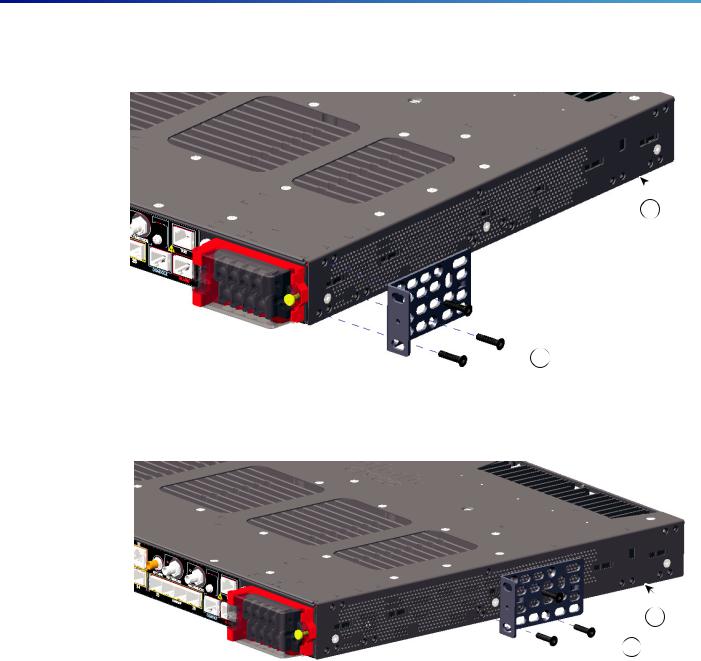
Switch Installation
Installing the Switch
Figure 7 Attaching Brackets for 19-Inch Racks (Front bracket)
1
 2
2
Figure 8 Attaching Brackets for 19-Inch Racks (Mid Mount)
3
 2
2
349773
16
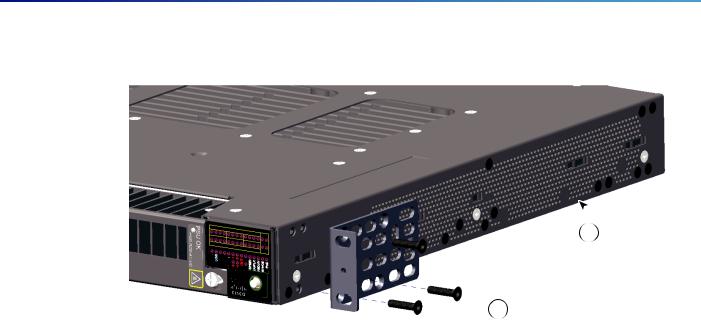
Switch Installation
Installing the Switch
Figure 9 Attaching Brackets for 19-Inch Racks (Rear Mount)
1
 2
2
Attaching Brackets for 19-Inch Racks for IP-30 Compliance (Optional)
Before installing the mounting brackets, you need to install the rubber plugs in the unused mounting holes. Figure 10 on page 18 shows a close-up of the rubber plug. You can install the rubber plugs in the holes as shown in Figure 11 on page 19.
17
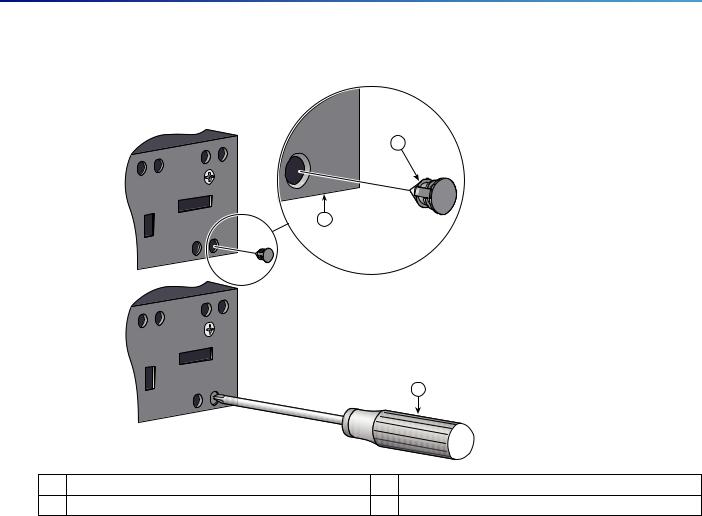
Switch Installation
Installing the Switch
Figure 10 Inserting the Rubber Plug
1
2
3
 255738
255738
1 |
Rubber plug |
3 |
Screwdriver |
2Switch
1.Identify your bracket mounting position. See Attaching Brackets for 19-Inch Racks, page 15.
2.Insert the rubber plugs in the appropriate holes on both sides of the switch. See Figure 11 on page 19.
3.Use a screwdriver or pen to completely push in the rubber plugs. See Figure 10 on page 18.
4.Install the brackets on both sides of the switch. See Attaching Brackets for 19-Inch Racks, page 15 and Attaching Brackets for 19-Inch Racks for IP-30 Compliance (Optional), page 17.
18
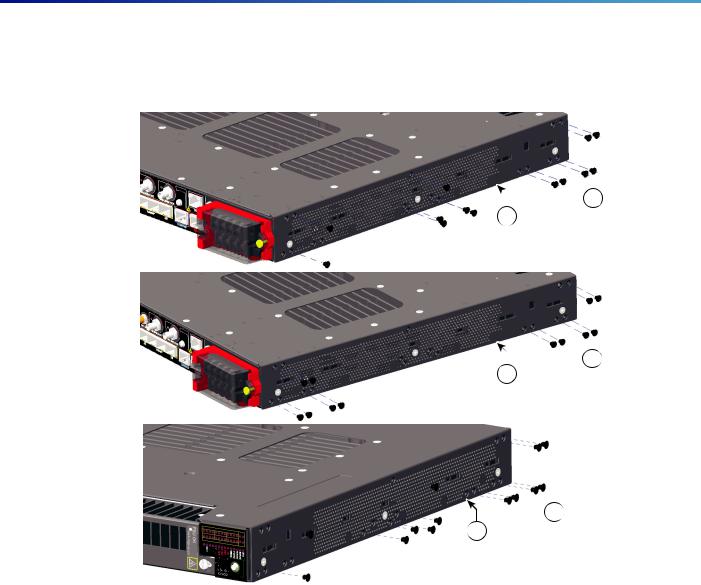
Switch Installation
Installing the Switch
Figure 11 Plug locations by position
 1
1
2
 1
1
3
 1
1
4
1 |
Rubber plug |
3 |
Mid-mounting position |
|
|
|
|
2 |
Rear-mounting position |
4 |
Front-mounting position |
|
|
|
|
Note: For IP-30 compliance: If you use 23-inch brackets or ETSI brackets, you can insert the rubber plugs in the same holes as shown in Figure 11 on page 19 before installing the brackets.
Attaching Brackets for 23-Inch Racks
If 23-inch brackets (RM-RGD-23IN=) are required, follow steps in Figure 12 on page 20 for installation.
Note: 23-inch and ETSI brackets should not be used in high vibration environments, including any railway application (EN50155).
Note: For IP-30 compliance: If you use 23-inch brackets or ETSI brackets, you can insert the rubber plugs in the same holes as shown in Figure 11 on page 19 before installing the brackets.
19
